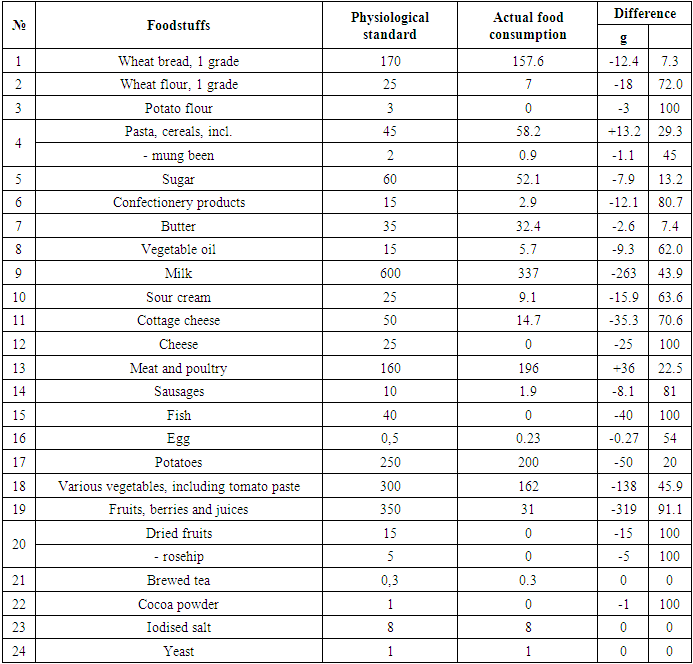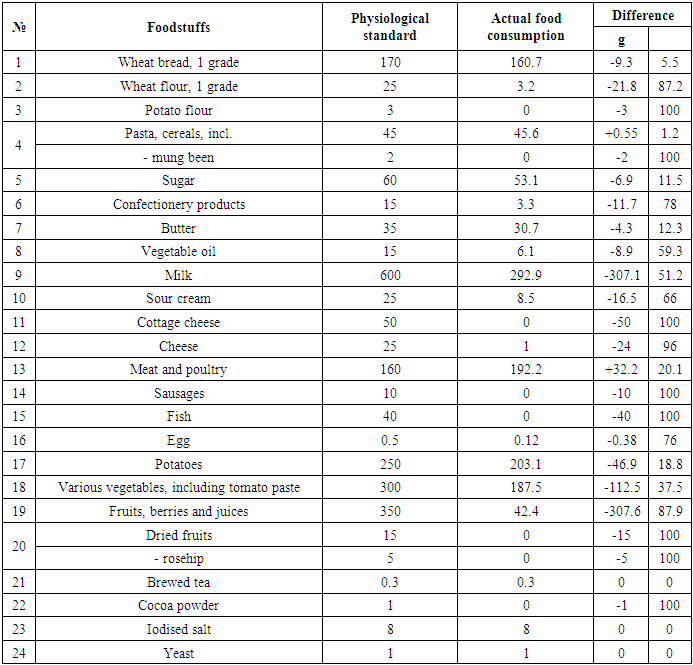-
Paper Information
- Next Paper
- Previous Paper
- Paper Submission
-
Journal Information
- About This Journal
- Editorial Board
- Current Issue
- Archive
- Author Guidelines
- Contact Us
American Journal of Medicine and Medical Sciences
p-ISSN: 2165-901X e-ISSN: 2165-9036
2024; 14(11): 2742-2745
doi:10.5923/j.ajmms.20241411.13
Received: Oct. 8, 2024; Accepted: Nov. 1, 2024; Published: Nov. 7, 2024

Actual Set of Products Provided to Children of Preschool Educational Organizations with 4 Meals Per Day
Kamilova Roza1, Laylo Basharova2, Isakova Lola3
1DSc, Professor, Deputy Director, Research Institute of Sanitary, Hygiene and Occupational Diseases, Tashkent, Uzbekistan
2PhD, Postdoctoral Student, Research Institute of Sanitary, Hygiene and Occupational Diseases, Tashkent, Uzbekistan
3PhD, Senior Researcher, Research Institute of Sanitary, Hygiene and Occupational Diseases, Tashkent, Uzbekistan
Correspondence to: Kamilova Roza, DSc, Professor, Deputy Director, Research Institute of Sanitary, Hygiene and Occupational Diseases, Tashkent, Uzbekistan.
| Email: |  |
Copyright © 2024 The Author(s). Published by Scientific & Academic Publishing.
This work is licensed under the Creative Commons Attribution International License (CC BY).
http://creativecommons.org/licenses/by/4.0/

Dietary malnutrition of preschool children is one of the global problems. Many children have a deficiency of basic nutritional substances, as well as vitamins and minerals. The purpose of this study was to assess the actual intake and consumption of food products by preschool children. Materials and methods: The study was conducted in preschool education institutions with 9-10.5-hour stay of children and 4 meals a day, located in Tashkent city. Eighty-two menu-sheets (38 for winter-spring and 44 for summer-autumn periods of the year) designed for preschool children were studied. Foodstuffs availability in the studied preschool education institutions amounted to 79%; such foodstuffs as potato flour, fish, cheese, dried fruits and cocoa were completely absent. Depending on the season of the year, the examined children's diet was characterized by the lack of butter, sugar and potatoes (1.2 times), vegetables and milk (2 times), vegetable oil, sour cream and eggs (3 times). Low consumption of confectionery and wheat flour (5 times), cottage cheese (7 times), sausages, fruits, berries and juices (10 times) indicates their significant deficiency in the diet. The present research could be the basis for the development of adequate measures aimed at filling nutrient deficiencies and improving the diet of organized children.
Keywords: Average daily intake, Actual nutrition, Ration, Set of food products, Menu-sheets, Children of preschool educational institutions
Cite this paper: Kamilova Roza, Laylo Basharova, Isakova Lola, Actual Set of Products Provided to Children of Preschool Educational Organizations with 4 Meals Per Day, American Journal of Medicine and Medical Sciences, Vol. 14 No. 11, 2024, pp. 2742-2745. doi: 10.5923/j.ajmms.20241411.13.
1. Introduction
- In many countries, regardless of their socio-economic development, the structure of preschool children's diets is characterized by a persistent decrease in biologically nutritious foods [2,4-6,8-13,15,20]. According to the set of products, children do not get enough different types of the foods, including fish, meat and meat products, dairy and fermented milk products, eggs, vegetables and fruits, butter, and against this background receive 1.5 times more bread and bakery products, potatoes, pasta, cereals and 2-4.5 times more sweets and candies [1,3,14,16]. According to foreign scientists, the deficiency of the most important nutritional substances (complete proteins, fats and complex carbohydrates), as well as vitamins and minerals in children's diets reaches up to 50% [2,4,6,7,12,17-19,20]. The organization of nutrition is of great importance in the preschool education system of children. The nutrition regime in preschool education institutions (PEIs) depends on the number of hours of daily attendance. In Uzbekistan, there are PEIs with different lengths of stay (3-4 hours, 9-10.5 hours, 12 and 24 hours) and different multiplicity of meals (1, 3, 4 or 5 meals a day).In this regard, the study of nutritional adequacy of preschool children is an urgent public health problem, and the results of such studies will make it possible to develop targeted preventive measures aimed at ensuring nutritional adequacy in preschool education institutions.Objective of the study was to assess the actual set and consumption of food products by preschool children.
2. Materials and Methods
- The study was conducted at the bases of PEIs with 9-10.5-hour stay of children and 4 meals a day, located in Tashkent city. The object of the study was 82 menu-sheets (38 for winter-spring and 44 for summer-autumn periods of the year) designed for preschool children. The average daily actual consumption of products used in the preparation of meals during the week was calculated for weekdays.We analyzed the menu-sheets based on the permission of the City Department of Public Education and the written informed voluntary consent of the heads of PEIs.The obtained data were subjected to statistical processing using Excel-2016 program.
3. Results and Discussion
- In the diet of organized children in the winter-spring period of the year, 5 out of 24 food items (potato flour, cheese, fish, dried fruit and cocoa) were absent, i.e. the food supply was 79.2% on average.The reduced amount of products consumed during the winter-spring period of the year, such as sugar (1.2 times or by 13.2%), potatoes (1.3 times or by 20%), milk (1.8 times or by 43.9%), vegetables (1.8 times or by 45.9%), eggs (2.2 times or by 54%), vegetable oil (2.6 times or by 62%), sour cream (2, 7 times or by 63.6%), cottage cheese (by 3.4 times or by 70.6%), wheat flour (by 3.6 times or by 72%), confectionery (by 5.2 times or by 80.7%), sausages (by 5.3 times or by 81%), fruits, berries and juices (by 11.3 times or by 91.1%), indicates their deficiency in the diet of surveyed children (table 1).
|
|
4. Conclusions
- 1. Such food products as potato flour, fish, cheese, dried fruits and cocoa were completely absent in the diet of organized children in winter-spring and summer-autumn periods of the year out of 24 recommended items. Food availability in the studied PEIs was 79%.2. The diet of the surveyed children in different periods of the year was characterized by a lack of butter, sugar and potatoes (1.2 times), vegetables and milk (2 times), vegetable oil, sour cream and eggs (3 times). Low consumption of confectionery and wheat flour (5 times), cottage cheese (7 times), sausages, fruits, berries and juices (10 times) indicates their significant deficiency in the diet.3. In winter-spring and summer-autumn periods of the year, such foodstuffs as meat and poultry (1.2 times), cereals and pasta (1.3 times) prevailed in the diet of the surveyed PEIs in excessive quantities.
 Abstract
Abstract Reference
Reference Full-Text PDF
Full-Text PDF Full-text HTML
Full-text HTML
